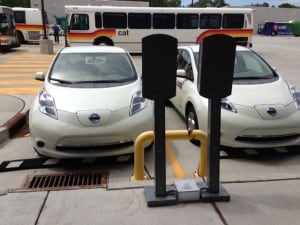 There are not many EV cars such as the Toyota Prius EV that can be charged wirelessly, yet, however a new report for WinterGreen Research shows lots of wireless charging pads landing for cars in the next few years, to the tune of $4.6 Billion in 2019.
There are not many EV cars such as the Toyota Prius EV that can be charged wirelessly, yet, however a new report for WinterGreen Research shows lots of wireless charging pads landing for cars in the next few years, to the tune of $4.6 Billion in 2019.
Worldwide wireless car charging markets should achieve significant growth, notes the report.
According to Susan Eustis, lead author of the WinterGreen Research study “wireless car charging represents the major force impacting electrical charging. Car vendors are coming together to create standards and to leverage standards to gain competitive advantage with highly differentiated product sets.”
The report indicates that markets at $1.7 million will reach $4.6 billion by 2019. Growth will be caused by rapid adoption of electric vehicles that increases the user base up in 2019.
While wireless car charging is considered a perquisite for an EV, it is soon expected to become a necessary feature.
Inductive wireless charging does not use as much grid electricity to achieve device charging. Electricity is generated in a coil. Inductive charging means the primary coil in the charger induces a current in the secondary coil in the device being charged.
Wireless charging in the automotive industry brings inductive power for EV cars. Short distance power transmission is based on magnetic induction. All the driver has to do is park the car over a wireless charging pad and the car charges.
Wireless inductive charging is gaining popularity for use in consumer rechargeable applications such as cordless power tools, net books, notebooks and other power-hungry rechargeable devices.
Market driving forces relate primarily to the need for efficient power generation for autos. Wireless car charger manufacturers are positioning car models with wireless charging to drive demand at the high end.
Many electric vehicle car vendors are making wireless power a reality.The Chevy Volt and the Nissan Leaf are the only two EV that can use wireless charging.
Wireless power is an emerging technology that creates a better charging experience for consumers. Just as Wi-Fi replaced the need to use an Ethernet cable for Internet connectivity, so also wireless power is making recharging wirelessly a feature that is demanded by consumers with an electric vehicle. .
Wireless charging is more accurately described as “inductive charging” because it uses magnetic induction.
Cars must have the appropriate hardware in them to support wireless charging — a device without the appropriate coil cannot charge wirelessly.
Inductive charging uses magnetism to transmit energy. The current coming from the wall power outlet moves through the wire in the wireless charger, creating a magnetic field. The magnetic field creates a current in the coil inside the device. This coil is connected to the battery and the current charges the battery. Cars must have the appropriate hardware in them to support wireless charging — a device without the appropriate coil cannot charge wirelessly.